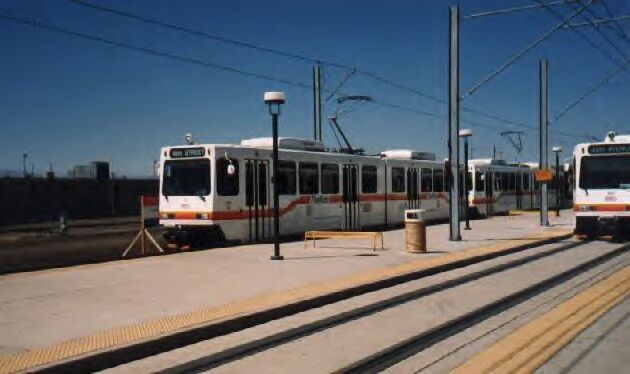 Monorail systems are occasionally
proposed as an alternative to light rail transit (LRT). However, unlike
urban LRT systems, most monorail applications appear to be relatively
short, shuttle-type or simple point-to-point services with few or no branches. in Japan, the country
with the highest concentration of monorails in actual urban revenue
service, and the most extensive monorail fleets, most monorails
appear to serve as feeders to conventional, heavy-duty rail
systems or for special applications in extremely dense and highly
congested urban conditions. (See monorail trainset on beamway in Kitakyushu, right.)
Monorail systems are occasionally
proposed as an alternative to light rail transit (LRT). However, unlike
urban LRT systems, most monorail applications appear to be relatively
short, shuttle-type or simple point-to-point services with few or no branches. in Japan, the country
with the highest concentration of monorails in actual urban revenue
service, and the most extensive monorail fleets, most monorails
appear to serve as feeders to conventional, heavy-duty rail
systems or for special applications in extremely dense and highly
congested urban conditions. (See monorail trainset on beamway in Kitakyushu, right.)
The relatively small size typical of Japanese monorail systems is
indicated by their fleet sizes. Leroy Demery, Jr., lead co-author of the
prospective Electric Railways of Japan, Volume 1, Second
Edition, has prepared fleet list information based on the 2001
issue of Shitetsu sharyo hensei-hyo (Compiled List of Private-sector Railway Rolling Stock), published in Tokyo. The following
listing uses the rollingstock code from the Japan book series
(patterned after the "Taplin code," devised by Light Rail Transport
Association's Mike Taplin): "M" = motor car; "T" = trailer car.
Japanese Monorail Systems: Rollingstock and Trainsets
| City-System |
Rollingstock Type |
Trainset Configurations |
| Chiba |
M40 |
20 two-car formations (air-conditioned, aluminum bodies).
A small number of runs during
the morning peak period on Line
2 use four-car trains. |
| Inuyama |
M6 |
2 three-car formations. |
| Kitakyushu |
M40 |
10 four-car formations. (in an
apparent cost-cutting measure,
no air-conditioning is provided.) |
| Naha |
M24 |
12 two-car
formations. Judging from website photos, one can conclude that stations
are built for four-car trains. |
| Osaka |
M52 |
13 four-car formations (air-conditioned, aluminum bodies). |
| Tokyo-Haneda |
M114 |
19 six-car formations (air-conditioned, aluminum bodies). |
| Tokyo-Shonan |
M20 T1 |
7 three-car formations. |
| Tokyo-Tama |
M60 |
15 four-car formations.
|
| Tokyo-Ueno
Park |
M2 |
1 two-car formation. |
In assessing the size of these Japanese monorail applications
based on their comparative fleet sizes, it is useful to keep in mind
that each Japanese monorail car is roughly half as long as a
"typical" American LRV (light rail vehicle). Using this as a basis
for conversion, one can make the rough calculations of equivalent
LRV fleet sizes for the major operating urban Japanese systems.
(Smaller lines, performing simple shuttle-type or circulator
services, have been excluded.)
Japanese Monorail Fleets: Equivalent LRVs
| City-System |
Train Configurations |
Equivalent LRVs |
| Chiba |
20 2-car trainsets |
20 |
| Kitakyushu |
10 4-car trainsets |
20 |
| Naha |
12 2-car trainsets |
12 |
| Osaka |
13 4-car trainsets |
26 |
| Tokyo-Haneda |
19 6-car trainsets |
57 |
| Tokyo-Shonan |
7 3-car trainsets |
11 |
| Tokyo-Tama |
15 4-car trainsets |
30 |
 Most of these fleet sizes seem
quite small compared with LRV fleets even for modest-sized North American cities operating LRT.
(See photo of LRV storage yard in Denver, left.) For example, using data from a presentation by John
Schumann to the 2000 National LRT Conference, the following table lists LRT fleet sizes for a
number of major LRT installations:
Most of these fleet sizes seem
quite small compared with LRV fleets even for modest-sized North American cities operating LRT.
(See photo of LRV storage yard in Denver, left.) For example, using data from a presentation by John
Schumann to the 2000 National LRT Conference, the following table lists LRT fleet sizes for a
number of major LRT installations:
US LRT Systems: Fleet Sizes
| City-System |
LRVs in
Fleet |
| Baltimore |
53 |
| Calgary |
85 |
| Dallas |
95 |
| Denver |
31 |
| Hudson-Bergen |
29 |
| LA Blue Line |
69 |
| Portland |
72 |
| Sacramento |
36 |
| St. Louis |
56 |
| Salt Lake City |
23 |
| San Diego |
123 |
| San Jose |
50 |
This analysis would appear to suggest that, on the whole,
Japanese urban revenue monorail systems – even those functioning as the main rail transit system of a city – are much
smaller-scale operations than comparative North American LRT systems.
Data and portions of this report have been adapted from material
provided by Leroy W. Demery, Jr.
